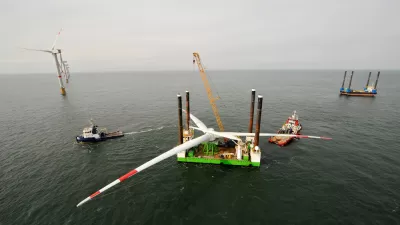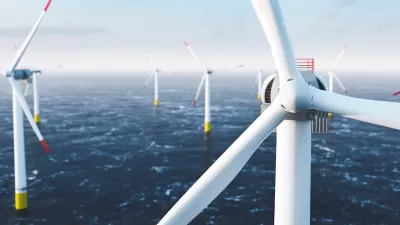The anticipated approval of the largest proposed offshore wind farm in the U.S., a 90-megawatt facility off Montauk on Long Island, was unexpectedly delayed. But what will soon be the nation's first offshore wind farm did receive some good news.

The United States is woefully behind other developed nations in its development of the huge renewable energy source that has been proven to be successfully tapped by offshore wind farms.
"3,018.5 MW of new offshore wind power capacity was connected to the grid during 2015 in Europe, a 108.3% increase over 2014 and the biggest yearly addition to capacity to date," according to WindEurope.
The Long Island Power Authority had "plans to approve a 90 megawatt wind farm off the coast of New York that would become the largest in the U.S. when completed," reported Chris Martin, cleantech & renewable energy reporter for Bloomberg News, on July 14.
Deepwater Wind LLC was selected to install 15 offshore turbines about 30 miles (48 kilometers) east of Montauk for a project that the utility’s board expects to approve at a meeting on July 20, said Sid Nathan, a spokesman for the state-owned utility, which is operated by Public Service Enterprise Group Inc.
Montauk, located at the tip of the eastern end of the south shore of Long Island, juts into the Atlantic Ocean.
"But late Tuesday, LIPA trustees abruptly postponed their Wednesday meeting, citing a request by the New York State Energy and Research Development Authority to hold off until Albany releases an 'offshore-wind master plan' that further defines the state’s clean-energy standards," reports Gregory Zeller for Innovate Long Island.
New York's Clean Energy Standard, currently under development [PDF], is also referred to as a Renewable Portfolio Standard.
The project, known as the South Fork Wind Farm, will "provide early support to the Town of East Hampton’s long-term goal of achieving 100 percent renewable energy use by 2030," according to Deepwater Wind.
"The delay takes some wind out of the sails of a project that was breezing toward history," adds Zeller.
The plan has also been endorsed by environmentalists and by Gov. Andrew Cuomo, who’s set an ambitious goal of supplying 50 percent of New York’s electricity through renewable sources by 2030. Prior to the trustees’ postponement, Cuomo urged the LIPA board to approve the offshore plan, noting its environmental and economic advantages.
California has the same goal, though it was also codified with the passage of SB 350 last year.
Heather Leibowitz, director of citizen-based advocacy group Environment New York, called LIPA’s approval “key” to meeting Cuomo’s 2030 goals and “to putting the Empire State on a path toward an economy powered entirely by renewable energy.” [See study supporting a 100 percent renewable goal by 2030.].
The delay is the second in as many months. "The state is expected to unveil its wind-energy strategy within the next few weeks," adds Zeller.
South Fork Wind Farm can be confused with the larger Deepwater ONE project, "located roughly halfway between Montauk, N.Y., and Martha’s Vineyard, Mass., with the potential for more than 1,000 MW of offshore wind development," according to the company's website. The larger project was rejected by LIPA in December 2014.
Good news for Block Island Wind Farm
Deepwater Wind's other project, the Block Island Wind Farm, which we last reported as being under construction, was the subject of a lawsuit filed by the Rhode Island Manufacturers Association and others that charged it would raise utility rates. The suit was dismissed because the statute of limitations had passed, reports the Associated Press on July 18.
The 30 megawatt, five-turbine is expected to begin operation later this year, producing renewable energy for Rhode Island. It "is part of an ambitious multi-state strategy to ultimately generate 1,000 MW of electricity with environmentally friendly wind farms off the coasts of New York, Rhode Island and Massachusetts," adds Zeller.
Hat tip to Ed Mainland.
FULL STORY: LIPA Trustees Postpone Wind-Farm Vote

Alabama: Trump Terminates Settlements for Black Communities Harmed By Raw Sewage
Trump deemed the landmark civil rights agreement “illegal DEI and environmental justice policy.”

Study: Maui’s Plan to Convert Vacation Rentals to Long-Term Housing Could Cause Nearly $1 Billion Economic Loss
The plan would reduce visitor accommodation by 25% resulting in 1,900 jobs lost.

Why Should We Subsidize Public Transportation?
Many public transit agencies face financial stress due to rising costs, declining fare revenue, and declining subsidies. Transit advocates must provide a strong business case for increasing public transit funding.

Paris Bike Boom Leads to Steep Drop in Air Pollution
The French city’s air quality has improved dramatically in the past 20 years, coinciding with a growth in cycling.

Why Housing Costs More to Build in California Than in Texas
Hard costs like labor and materials combined with ‘soft’ costs such as permitting make building in the San Francisco Bay Area almost three times as costly as in Texas cities.

San Diego County Sees a Rise in Urban Coyotes
San Diego County experiences a rise in urban coyotes, as sightings become prevalent throughout its urban neighbourhoods and surrounding areas.
Urban Design for Planners 1: Software Tools
This six-course series explores essential urban design concepts using open source software and equips planners with the tools they need to participate fully in the urban design process.
Planning for Universal Design
Learn the tools for implementing Universal Design in planning regulations.
Smith Gee Studio
Alamo Area Metropolitan Planning Organization
City of Santa Clarita
Institute for Housing and Urban Development Studies (IHS)
City of Grandview
Harvard GSD Executive Education
Toledo-Lucas County Plan Commissions
Salt Lake City
NYU Wagner Graduate School of Public Service




























